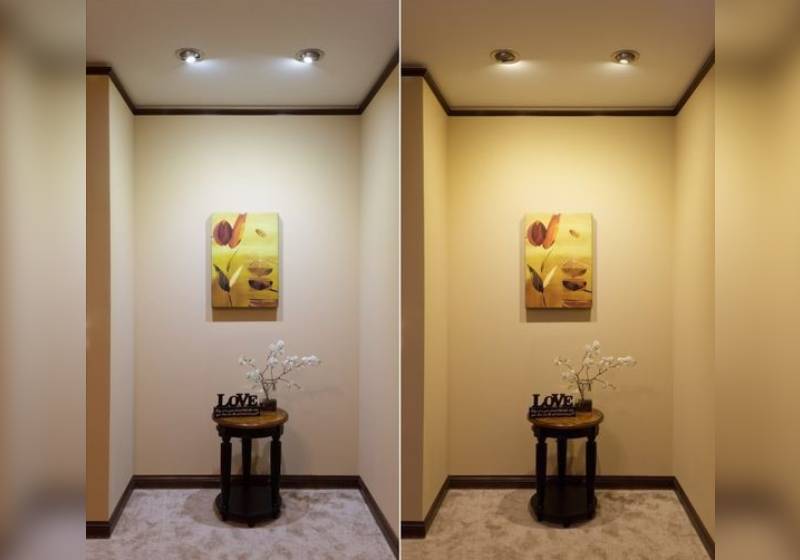Warm white, cool white: How to choose a suitable colour temperature for each space in the house


Since the revolutionary idea of Human Centric Lighting, the planning of lighting in the house has become an issue closely related to our health and wellbeing.
We now know that the wrong colour temperature of lighting for the occasion can harm our eyes, and sometimes even our natural sleep pattern. Warm white or cool white, that is the question.
Check out the guide below and plan your lighting accordingly!
COLOUR TEMPERATURE: THE BASICS

When the colour temperature is low, the light tends to be warmer, more yellow. And when the colour temperature is high, the light tends to be cooler, more bluish in tone.
| Warm white | ~3000 K |
| Normal daylight | ~4000 K |
| Bright, cool white | ~6000 K |
LIVING ROOM

For the living room, we suggest using cool white light for a boost of mental concentration, as well as a heightened sense of transparency.
You can add a bit of warmth and variety to the space with a warm-white floor lamp.
If you have only one main lamp in the living room, making extra space for a floor lamp might be very difficult.
To up the amount of light in the space, you can consider installing a recessed ceiling with light troughs.
BEDROOM

For the bedroom, opt for warm white lighting with lower colour temperature, ranging from 2700 - 3000K.
This is because cool white light suppresses the secretion of the 'sleepy hormone', melatonin, and interferes with our body's circadian rhythm, messing with our sleep.
Take extra care to create a sense of warmth and comfort in the bedroom, since the space is where we rest and recuperate from a busy day.
If your bedroom also functions as a study, you can consider installing lights with a colour temperature of 3000 - 4000K.
Alternatively, you can purchase a table lamp for reading and studying purposes, so that the comforting atmosphere is not compromised.
STUDY ROOM

If you are so lucky to have a study of your own, opt for even and bright lighting with a colour temperature of 4000 - 6000K.
The position and direction of lighting is an important matter in the study room.
Do not install lighting behind the chair where you sit, since the shadows cast on your reading material will strain your eyes and tire you out quickly.
Nowadays you can find table lamps specifically designed for reading and studying.
If you need an extra bit of brightening up, consider installing light troughs on the ceiling.
KITCHEN

Cooking requires a great amount of concentration, which means cool white lights are more suitable for the kitchen. After all, you're going to wield a knife and light a fire there.
In fact, all kitchens in restaurants are installed with cool white lights. Lighting with a higher colour temperature (4000 - 6000K) is installed in the kitchen also because of hygiene concerns.
Adequate lighting is conducive to effective cleaning and spotting dirt and grime.
Overall, the kitchen looks cleaner in a cool white light.
According to interior designers, installing spotlights below the cupboard or the countertop can both beautify the space and make cooking safer.

Although the dining room is usually connected to the living room, the former almost always has its own set of lighting distinct from the lighting of the living room.
Under a warm white light, the colour of food increases in saturation and this raises our appetite at mealtime.
The best light for the dining room has a colour temperature of 3000K, and a colour rendering index of above 80.
This is why you see high-end restaurants placing a warm white lamp or a candle on their tables.
Besides the purpose of illumination, the lights also improve the diners' appetite.
BATHROOM

The bathroom is where we relax and unwind.
By that logic, the colour temperature of bathroom lighting should not go above 4000K.
But most bathrooms have cool white lights installed instead, which allow you to see clearly. This is mostly due to safety concerns as the bathroom can be slippery.
To reconcile the need for relaxation and concerns of safety, you can choose to install extra light near the washing basin and the bathtub/ shower stall.
Wall sconces and spotlights are good options for bathroom lighting.
Remember that since the bathroom is often humid and warm, when purchasing lighting for the bathroom, opt for ones with good waterproofing and heat-dissipating properties.
CONCLUSION
When dealing with home lighting problems, send a bit of extra time to figure out how the lighting can best improve your quality of life, as well as your health.
This article was first published in Renonation.